Cisco Systems SGH-Blast User Manual

t729.book Page 1 Thursday, July 5, 2007 3:47 PM
SGH-Blast Series
P O R T A B L E Q U A D - B A N D
M O B I L E P H O N E
User Guide
Please read this manual before operating your phone, and keep it for future reference.

t729.book Page 2 Thursday, July 5, 2007 3:47 PM
Intellectual Property
All Intellectual Property, as defined below, owned by or which is otherwise the property of Samsung or its respective suppliers relating to the SAMSUNG Phone, including but not limited to, accessories, parts, or software relating there to (the “Phone System”), is proprietary to Samsung and protected under federal laws, state laws, and international treaty provisions. Intellectual Property includes, but is not limited to, inventions (patentable or unpatentable), patents, trade secrets, copyrights, software, computer programs, and related documentation and other works of authorship. You may not infringe or otherwise violate the rights secured by the Intellectual Property. Moreover, you agree that you will not (and will not attempt to) modify, prepare derivative works of, reverse engineer, decompile, disassemble, or otherwise attempt to create source code from the software. No title to or ownership in the Intellectual Property is transferred to you. All applicable rights of the Intellectual Property shall remain with SAMSUNG and its suppliers.
Samsung Telecommunications America (STA), LLC
Headquarters: |
Customer Care Center: |
1301 E. Lookout Drive |
1000 Klein St. |
Richardson, TX 75082 |
Plano, TX 75074 |
|
Toll Free Tel: 1.888.987.HELP (4357) |
Internet Address: http://www.samsungusa.com
©2007 Samsung Telecommunications America, LLC is a registered trademark of Samsung Electronics America, Inc. and its related entities.
Do you have questions about your Samsung Mobile Phone?
For 24 hour information and assistance, we offer a new FAQ/ARS System (Automated Response System) at:
www.samsungwireless.com/support
GH68-14547A
Licensed by Qualcomm Incorporated under one or more of the following patents: U.S. Patent No. 4, 901, 307; 5, 056, 109; 5, 099, 204; 5, 101, 501; 5, 103, 459; 5, 107, 225; 5, 109, 390.
Printed in Korea
Openwave® is a registered Trademark of Openwave, Inc.
RSA® is a registered Trademark RSA Security, Inc.

t729.book Page 3 Thursday, July 5, 2007 3:47 PM
Disclaimer of Warranties; Exclusion of Liability
EXCEPT AS SET FORTH IN THE EXPRESS WARRANTY CONTAINED ON THE WARRANTY PAGE ENCLOSED WITH THE PRODUCT, THE PURCHASER TAKES THE PRODUCT "AS IS", AND SAMSUNG MAKES NO EXPRESS OR IMPLIED WARRANTY OF ANY KIND WHATSOEVER WITH RESPECT TO THE PRODUCT, INCLUDING BUT NOT LIMITED TO THE MERCHANTABILITY OF THE PRODUCT OR ITS FITNESS FOR ANY PARTICULAR PURPOSE OR USE; THE DESIGN, CONDITION OR QUALITY OF THE PRODUCT; THE PERFORMANCE OF THE PRODUCT; THE WORKMANSHIP OF THE PRODUCT OR THE COMPONENTS CONTAINED THEREIN; OR COMPLIANCE OF THE PRODUCT WITH THE REQUIREMENTS OF ANY LAW, RULE, SPECIFICATION OR CONTRACT PERTAINING THERETO. NOTHING CONTAINED IN THE INSTRUCTION MANUAL SHALL BE CONSTRUED TO CREATE AN EXPRESS OR IMPLIED WARRANTY OF ANY KIND WHATSOEVER WITH RESPECT TO THE PRODUCT. IN ADDITION, SAMSUNG SHALL NOT BE LIABLE FOR ANY DAMAGES OF ANY KIND RESULTING FROM THE PURCHASE OR USE OF THE PRODUCT OR ARISING FROM THE BREACH OF THE EXPRESS WARRANTY, INCLUDING INCIDENTAL, SPECIAL OR CONSEQUENTIAL DAMAGES, OR LOSS OF ANTICIPATED PROFITS OR BENEFITS.
Blast_UVGF8_CH_070307_F9

t729.book Page 1 Thursday, July 5, 2007 3:47 PM
Table of Contents
Section 1: Getting Started .......................................................................... |
4 |
Activating Your Phone ............................................................................................... |
4 |
Switching the Phone On or Off .................................................................................. |
8 |
Setting Up Your Voice Mail ........................................................................................ |
8 |
Section 2: Understanding Your Phone ..................................................... |
10 |
Features of Your Phone ........................................................................................... |
10 |
Open View of Your Phone ........................................................................................ |
11 |
Keys ....................................................................................................................... |
11 |
Back View of Your Phone ........................................................................................ |
13 |
Closed View of Your Phone ..................................................................................... |
13 |
Display ................................................................................................................... |
14 |
Backlight ................................................................................................................ |
15 |
Section 3: Call Functions .......................................................................... |
17 |
Making a Call .......................................................................................................... |
17 |
Adjusting the Call Volume ....................................................................................... |
19 |
Answering a Call ..................................................................................................... |
19 |
Call Records ........................................................................................................... |
19 |
Silent Mode ............................................................................................................ |
22 |
Selecting Functions and Options ............................................................................. |
22 |
Section 4: Menu Navigation ..................................................................... |
28 |
Menu Navigation ..................................................................................................... |
28 |
Menu Outline .......................................................................................................... |
29 |
Section 5: Entering Text ........................................................................... |
36 |
Changing the Text Input Mode ................................................................................ |
36 |
Using T9 Mode ....................................................................................................... |
37 |
Using Number Mode ............................................................................................... |
38 |
Using Symbol Mode ................................................................................................ |
38 |
Using ABC Mode ..................................................................................................... |
38 |
Section 6: Messages ................................................................................. |
40 |
Types of Messages ................................................................................................. |
40 |
Text Messages ....................................................................................................... |
41 |
E-mail Messages .................................................................................................... |
42 |
Picture Messages ................................................................................................... |
43 |
Voice Note .............................................................................................................. |
46 |
Inbox ...................................................................................................................... |
47 |
Outbox .................................................................................................................... |
51 |
Drafts ..................................................................................................................... |
51 |
Templates .............................................................................................................. |
52 |
Voice mail ............................................................................................................... |
53 |
Delete all ................................................................................................................ |
54 |
Settings .................................................................................................................. |
54 |
1 |
|

t729.book Page 2 Thursday, July 5, 2007 3:47 PM
Broadcast Messages (SIM Card Dependent) ............................................................ |
55 |
Memory Status ....................................................................................................... |
57 |
Instant Messaging (IM) ............................................................................................ |
57 |
Section 7: Understanding Your Phonebook ............................................ |
59 |
Using Contacts List ................................................................................................. |
59 |
Finding a Phonebook Entry ...................................................................................... |
60 |
Dialing a Number from Phonebook .......................................................................... |
62 |
Editing a Caller Group ............................................................................................. |
63 |
Speed Dialing ......................................................................................................... |
63 |
My Profile ............................................................................................................... |
64 |
Block list ................................................................................................................. |
65 |
Management .......................................................................................................... |
65 |
FDN List .................................................................................................................. |
68 |
Section 8: t-zones .................................................................................... |
69 |
t-zones ................................................................................................................... |
69 |
Help ........................................................................................................................ |
72 |
Section 9: Fun & Apps ............................................................................. |
73 |
Files ........................................................................................................................ |
73 |
Games .................................................................................................................... |
81 |
Music Player ........................................................................................................... |
82 |
Camera ................................................................................................................... |
83 |
Voice recognition .................................................................................................... |
83 |
Image editor ........................................................................................................... |
87 |
Section 10: Organizer .............................................................................. |
89 |
Organizer ................................................................................................................ |
89 |
Alarm ...................................................................................................................... |
89 |
Calendar ................................................................................................................. |
91 |
Tasks ...................................................................................................................... |
94 |
Notes ...................................................................................................................... |
95 |
Calculator ............................................................................................................... |
95 |
Tip calculator .......................................................................................................... |
95 |
World Time ............................................................................................................. |
96 |
Synchronization ...................................................................................................... |
96 |
Unit conversion ....................................................................................................... |
98 |
Timer ...................................................................................................................... |
99 |
Stopwatch .............................................................................................................. |
99 |
Section 11: Changing Your Settings ..................................................... |
100 |
Time & date .......................................................................................................... |
100 |
Phone settings ...................................................................................................... |
102 |
Shortcut key ......................................................................................................... |
103 |
Display settings .................................................................................................... |
104 |
Bluetooth .............................................................................................................. |
107 |
Sound settings ...................................................................................................... |
108 |
Synchronization .................................................................................................... |
111 |
Table of Contents |
2 |

t729.book Page 3 Thursday, July 5, 2007 3:47 PM
Network services .................................................................................................. |
113 |
Security ................................................................................................................ |
115 |
Software update ................................................................................................... |
118 |
Memory status ...................................................................................................... |
118 |
Reset settings ....................................................................................................... |
118 |
Section 12: Camera ................................................................................. |
119 |
Using the Camera ................................................................................................. |
119 |
Take and Send ..................................................................................................... |
119 |
Record video ........................................................................................................ |
124 |
Photos .................................................................................................................. |
127 |
Videos .................................................................................................................. |
128 |
My Album ............................................................................................................. |
129 |
My Journal ........................................................................................................... |
130 |
Section 13: Health and Safety Information ............................................ |
131 |
Health and Safety Information ............................................................................... |
131 |
Samsung Mobile Products and Recycling .............................................................. |
133 |
UL Certified Travel Adapter ................................................................................... |
133 |
Consumer Information on Wireless Phones ........................................................... |
133 |
Road Safety .......................................................................................................... |
140 |
Responsible Listening ........................................................................................... |
141 |
Operating Environment ......................................................................................... |
143 |
Using Your Phone Near Other Electronic Devices ................................................... |
143 |
Potentially Explosive Environments ....................................................................... |
145 |
Emergency Calls ................................................................................................... |
146 |
FCC Notice and Cautions ....................................................................................... |
147 |
Other Important Safety Information ....................................................................... |
147 |
Product Performance ............................................................................................ |
148 |
Availability of Various Features/Ring Tones ........................................................... |
149 |
Battery Standby and Talk Time ............................................................................. |
149 |
Battery Precautions .............................................................................................. |
149 |
Care and Maintenance .......................................................................................... |
150 |
Section 14: Warranty Information .......................................................... |
152 |
Standard Limited Warranty ................................................................................... |
152 |
Index ......................................................................................................... |
157 |
3
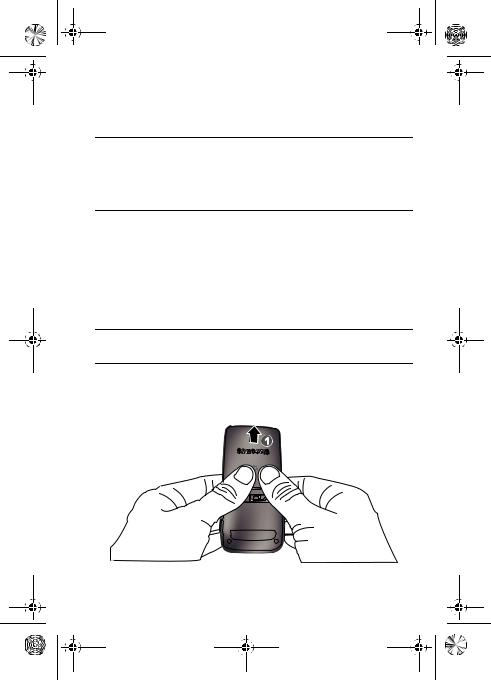
t729.book Page 4 Thursday, July 5, 2007 3:47 PM
Activating Your Phone
Section 1: Getting Started
Topics Covered
•Activating Your Phone
•Switching the Phone On or Off
•Setting Up Your Voice Mail
This section explains how to start using your phone by first configuring your hardware, activating your service, and then setting up your voice mail.
Activating Your Phone
When you subscribe to a cellular network, you are provided with a plug-in SIM card loaded with your subscription details, such as your PIN, available optional services, and many others features.
Installing the SIM Card
Important!: The plug-in SIM card and its contacts information can be easily damaged by scratching or bending, so be careful when handling, inserting, or removing the card.
Keep all SIM cards out of reach of small children.
If necessary, switch off the phone by holding down the  key until the power-off image displays.
key until the power-off image displays.
1.Remove the battery cover by sliding the battery cover in the direction of the arrow.
Getting Started |
4 |
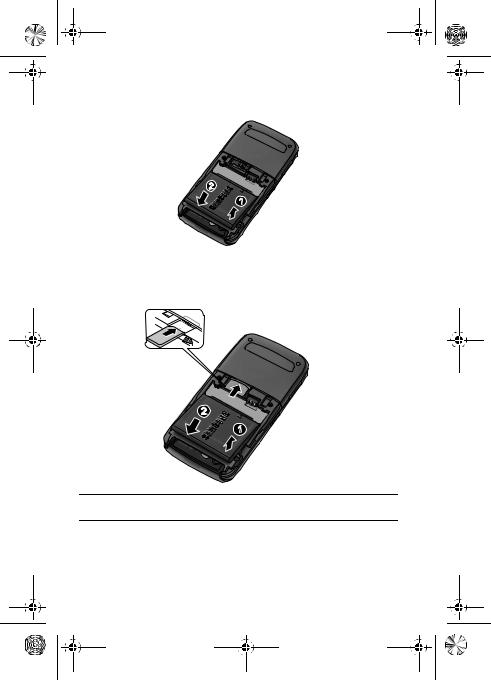
t729.book Page 5 Thursday, July 5, 2007 3:47 PM
2.Carefully lift the battery cover away from the bottom of the phone.
3.Lift up and remove the battery.
4.Carefully slide the SIM card under the metal bracket and into the SIM card socket until the card locks into place. Make sure that the card’s gold contacts face into the phone and that the upper-left angled corner of the card is positioned as shown below.
Note: If the card is not inserted correctly, the phone does not detect the SIM card. Remove the battery and re-orient the card back into the slot.
5.Replace the battery:
•(1) Slide the battery back into the compartment so that the tabs on the end align with the slots at the bottom of the phone.
•(2) Press the battery down until it clicks into place.
5
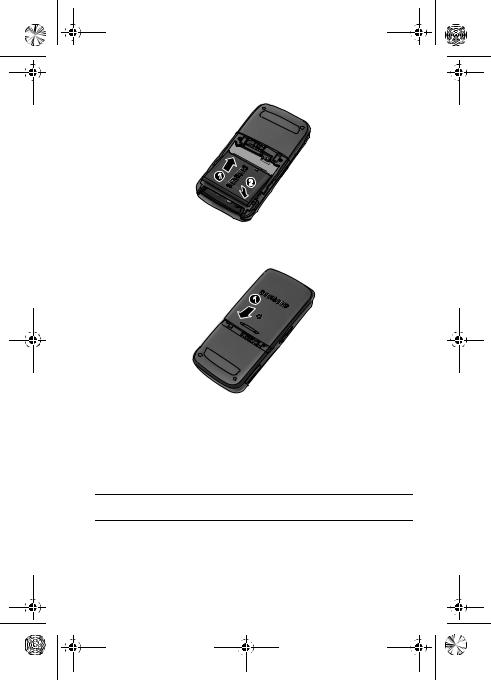
t729.book Page 6 Thursday, July 5, 2007 3:47 PM
Activating Your Phone
Reinstall the battery cover by sliding it back onto the phone until you hear it securely click. Make sure the battery is properly installed before switching on the phone.
Charging a Battery
Your phone is powered by a rechargeable Li-ion battery. A travel adapter, which is used for charging the battery, is included with your phone. Use only approved batteries and chargers. Ask your local Samsung dealer for further details.
You can use the phone while the battery is charging, but doing so requires additional charging time.
Note: You must fully charge the battery before using your phone for the first time. A discharged battery recharges fully in approximately 4 hours.
1.With the battery installed, temporarily remove the plastic cover on the right side of the phone and plug in the travel adapter’s connector into the jack.
Getting Started |
6 |

t729.book Page 7 Thursday, July 5, 2007 3:47 PM
Important!: Verify that the handset battery is installed prior to connecting the travel adapter. If the battery is not installed and the travel adapter is connected the handset continuously power cycles and prevents proper operation.
2. Plug the adapter’s power plug into a standard AC wall outlet.
+
Note: The previous illustration displays the incorrect method for connecting the charger. If attempted, damage to the accessory port occurs therefore voiding the phone’s warranty.
3.When charging is finished, unplug the adapter’s power plug from the AC wall outlet and then disconnect the travel adapter’s connector from the phone.
4. Resecure the plastic cover over the interface jack on the phone.
Warning!: Failure to unplug the travel adapter before you remove the battery, can cause damage to the phone.
7

t729.book Page 8 Thursday, July 5, 2007 3:47 PM
Switching the Phone On or Off
Low Battery Indicator
When the battery is weak and only a few minutes of talk time remain; a warning tone sounds and the “Battery low” message repeats at regular intervals on the display. In this condition, your phone conserves its remaining battery power, not by turning off the backlight, but by entering the dimming mode.
When the battery level becomes too low, the phone automatically turns off.
Switching the Phone On or Off
1.Press and hold the  key until the phone switches on.
key until the phone switches on.
2.If the phone asks you to enter the phone password, use the keypad to enter this password and press either the OK soft key or the  key.
key.
Note: For more information, refer to "Change password" on page 116.
3.If the phone asks for a PIN, use the keypad to enter the PIN and press
either the OK soft key or the  key. For further details, see "PIN check" on page 115.
key. For further details, see "PIN check" on page 115.
The phone searches for your network and after finding it, the term “T-Mobile” displays on the upper left half of your screen. Now you can make or receive calls.
Note: The display language is preset to Automatic at the factory. To change the language, use the Language menu. For more information, refer to "Language" on page 102.
4.When you wish to switch off the phone, press and hold the  key until the power-off image displays.
key until the power-off image displays.
Setting Up Your Voice Mail
For new users, follow the instructions below to set up voice mail:
1.In Idle mode, press and hold the  key on the keypad. You may be prompted to enter a password.
key on the keypad. You may be prompted to enter a password.
2.Follow the tutorial to create a password, a greeting, and your name.
Note: These steps may be different depending on your network.
Getting Started |
8 |

t729.book Page 9 Thursday, July 5, 2007 3:47 PM
Accessing Your Voice Mail
You can press and hold the  key on the keypad or use the phone’s menu to access your voice mail. To access voice mail using the menu:
key on the keypad or use the phone’s menu to access your voice mail. To access voice mail using the menu:
1.In Idle mode, press the Menu soft key.
2.Highlight Messages and press the Select soft key or the  key.
key.
3.Highlight Voice mail and press the Select soft key or the  key.
key.
4.Highlight Call voice mail and press the Select soft key or the  key. Your phone dials the specified voice mail number.
key. Your phone dials the specified voice mail number.
5.When connected, follow the voice prompts from the voice mail center.
Changing the Voice Mail Number
Your SIM card gives you the default service number of the voice mail center. However, should you need to change the number, use the following procedures:
1.In Idle mode, press the Menu soft key to access the Menu mode.
2.Highlight Messages and press the Select soft key or the  key.
key.
3.Highlight Voice mail and press the Select soft key or the  key.
key.
4.Highlight Voice server number and press the Select soft key or the
 key.
key.
5.Highlight Voice mail and press the Options soft key.
6.Highlight Edit and press the Select soft key or the  key. Or, you may highlight Delete to delete the number.
key. Or, you may highlight Delete to delete the number.
7.Edit the name if desired, and then press the Down Navigation key to edit the number.
8.Press the Options soft key, highlight the Save option, and press the Select soft key or the  key.
key.
9.Press the  key to return to Idle mode.
key to return to Idle mode.
9

t729.book Page 10 Thursday, July 5, 2007 3:47 PM
Features of Your Phone
Section 2: Understanding Your Phone
Topics Covered
•Features of Your Phone
•Open View of Your Phone
•Keys
•Back View of Your Phone
•Closed View of Your Phone
•Display
•Backlight
This section outlines some key features of your phone. It also displays the screen and the icons that display when the phone is in use.
Features of Your Phone
Your phone is lightweight, easy-to-use and offers many significant features. The following list outlines a few of the features included in your phone.
•1.3 Megapixal Camera with 4x Digital Zoom
•Bluetooth® Wireless Technology
•User friendly, menu driven access to features and options
•Instant Messaging capability
•Sound/Image media capability
•Fun & Apps feature provides files, sounds, images, videos, music, games, Music Player, camera, voice recognition, and image editor.
•Organizer feature provides alarms, calendar, tasks, notes, calculator, tip calculator, world time, synchronization, unit conversion, timer and Stopwatch.
Understanding Your Phone |
10 |

t729.book Page 11 Thursday, July 5, 2007 3:47 PM
Open View of Your Phone
The following illustrations show the main elements of your phone:
1. Earpiece |
2. Left Soft key |
3. Volume keys |
4. t-zone key |
5. Send key |
6. Voice mail key |
7. Alphanumeric |
keys |
8. Special function keys
16. Display
15.Navigation (Up/Down/Left/Right) keys
14. Right Soft key
13. OK (Select) key
12. Shortcut key
11. Power On/Off
(Exit) key
10.Cancel/Clear key
9.Microphone
Keys
The following list correlates to the illustrations.
1.Earpiece allows you to hear the other caller and the different ring tones or sounds offered by your phone.
2.Left Soft key allows you to select soft key actions or menu items corresponding to the bottom left line on the display screen.
3.Volume keys allow you to adjust the Ring volume in standby mode (with the phone open) or adjust the Speaker volume during a call. When receiving an incoming call, if you press the volume key, you can mute the ring tone. If you press and hold the volume key, you can reject the call.
4.t-zone key in Idle mode, acts as a t-zone shortcut key.
5.Send key allows you to make or answer a call. In Idle mode, recalls the last number dialed or received when held down.
6.Voice mail key allows you to quickly access your voice mail. Press and hold this key for two seconds to automatically dial your voice mail’s phone number.
11

t729.book Page 12 Thursday, July 5, 2007 3:47 PM
Keys
7.Alphanumeric keys allow you to enter numbers, letters, and some special characters.
8.Special Function keys allow you activate unique features while in Idle mode. In Idle mode, if you press and hold the # key, you can turn on the Silent Mode.
9.Microphone is used during phone calls and allows other callers to hear you clearly when you are speaking to them. It is also used in making voice note recordings.
10.Cancel/Clear key deletes characters from the display. In Menu mode, this key returns you to the previous menu level.
11.Power On/Off (Exit) key ends a call. Press and hold this key for two seconds to turn your phone on or off. While in the Menu mode, it returns the phone to Idle mode and then cancels your input.
12.Shortcut key opens the application switch window which allows you to select from a group of different applications without having to exit from the currently active application.
13.OK (Select) key allows you to accept the choices offered when navigating through a menu.
14.Right Soft key allows you to select soft key actions or menu items corresponding to the bottom right line on the display screen. It also provides quick access to your Phonebook.
15.Navigation key scrolls through the phone’s menu options and acts as a shortcut key from standby mode.
In Menu mode, scrolls through the phone’s menus and Phonebook. In Idle mode:
•Down key: allows you to directly access your Contact list.
•Up key: allows you to directly access the Call records.
•Left key: allows you to directly access Text messaging (New message).
•Right key: allows you to directly access Voice note.
Tip: When entering text, use the Left or Right Navigation key to mark the position of the cursor.
16.Display shows all the information needed to operate your phone, such as the received signal strength, phone battery level, and time.
Understanding Your Phone |
12 |
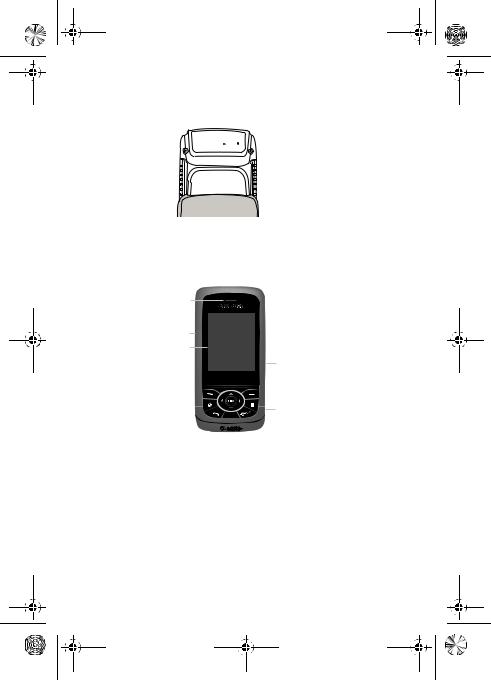
t729.book Page 13 Thursday, July 5, 2007 3:47 PM
Back View of Your Phone
The following illustration shows the back, open view of the phone.
1. Camera lens 








 2. Mirror (self portrait)
2. Mirror (self portrait)
1.Camera lens allows you to aim and shoot a picuture using the camera.
2.Mirror allows you to center the camera lens for self portraits.
Closed View of Your Phone
The following illustrations show the external elements of your phone
1.External speaker
2.Volume keys
3.External display
5. Camera key
7. Alphanumeric keys 8. Special function keys
4. Power/Accessory
Interface connector
1.External speaker allows you to hear the different ring tones or sounds offered by your phone.
2.Volume keys allow you to adjust the Ring volume in standby mode (with the phone open) or adjust the Speaker volume during a call. When receiving an incoming call, if you press the volume key, you can mute the ring tone. If you press and hold the volume key, you can reject the call.
3.External display shows the received signal strength, phone battery level, and the time.
13

t729.book Page 14 Thursday, July 5, 2007 3:47 PM
Display
4.Power/Accessory Interface connector allows you to connect a power cable or optional accessories, such as a USB/data cable or a hands-free headset for convenient, hands-free conversations.
5.Camera key allows you to take pictures when you are in camera mode. Launches the camera with a press.
Display
Your phone’s display screen provides a wealth of information about your phone’s status and options. The display has three areas:
Icons
Text and graphics area
Soft key function indicators
Icons
This list identifies the symbols you’ll see on your phone’s display screen:
Shows the received signal strength. The greater the number of bars, the stronger the signal.
Shows the level of your battery. The more bars you see, the more power remains.
Displays when a call is in progress.
Displays when the phone is not receiving a signal or is in
Airplane mode.
Displays when Bluetooth wireless technology is active.
Displays when Silent Mode is active.
Displays when you missed a call.
Understanding Your Phone |
14 |

t729.book Page 15 Thursday, July 5, 2007 3:47 PM
Displays when a new text message is received.
Displays when a new voice mail is received.
Displays when a new picture message is received.
Displays when you set an alarm to ring at a specified time. For more details, see "Alarm" on page 89.
Displays when the Call Forwarding feature is active. For more details, see "Call forwarding" on page 113.
Displays while you are connecting to the Internet.
Displays while your phone is synchronizing data with the network.
Backlight
A backlight illuminates the internal display and the keypad. When you press any key, the backlight comes on. It goes off when no keys are pressed within a given period of time, depending on the setting within the Backlight menu. The display turns off after one minute to conserve battery power.
The On setting is how long the keypad backlight is on. The Dim option is how much longer after the keypad backlight goes off that the display remains lit.
To specify the length of time the backlight is active, access the Backlight menu:
1.In Idle mode, press the Menu soft key to access the Menu mode.
2.Using the Navigation keys, scroll to the Settings icon. Press the Select soft key or the  key to enter the menu.
key to enter the menu.
3.Highlight the Display settings option and press the Select soft key or the
 key.
key.
4.Highlight the Backlight option and press the Select soft key or the
 key.
key.
5.Highlight the On option. Use the Left or Right Navigation key to select the time the backlight is on. You may choose between 15 sec, 30 sec,
1 min, 3 min, or 10 min.
15

t729.book Page 16 Thursday, July 5, 2007 3:47 PM
Backlight
6.Press the Down key to take you to the Dim option. Use the Left or Right Navigation key to select the time the Dimming mode is on. You may choose between Off, 15 sec, 30 sec, 1min, or 3 min.
7.Press the Save soft key to retain your new settings.
Display
Your phone has a display on the front of the phone. The display indicates when you receive an incoming call or message and also displays any alarms for the specified time. The backlight turns on and the corresponding icon displays on the screen.
The display shows the current time on a digital clock.
Understanding Your Phone |
16 |

t729.book Page 17 Thursday, July 5, 2007 3:47 PM
Section 3: Call Functions
Topics Covered
•Making a Call
•Adjusting the Call Volume
•Answering a Call
•Call Records
•Silent Mode
•Selecting Functions and Options
This section describes how to make or answer a call. It also explains the features and functionality associated with making or answering a call. For more information on Ringtones see "Ring tone" on page 109. For more information on Call Forwarding see
"Call forwarding" on page 113.
Making a Call
When the idle screen displays, enter the number you wish to dial and press the  key.
key.
Note: When you activate the Auto redial option in the Extra settings menu, the phone automatically redials up to 10 times when the person does not answer the call or is already on the phone, provided your call is not sent to voice mail. For more information, refer to "Extra settings" on page 103.
Making an International Call
1.Press and hold the  key. The + character displays.
key. The + character displays.
2.Enter the country code, area code, and phone number.
3.Press the  key to make the call.
key to make the call.
Correcting the Number
1.To clear the last digit displayed, press the  key.
key.
2.To clear any other digit in the number, press the Left or Right Navigation key until the cursor is immediately to the right of the digit to clear and then press the  key. You can also enter a missing digit.
key. You can also enter a missing digit.
3.To clear the entire display, press and hold the  key.
key.
17

t729.book Page 18 Thursday, July 5, 2007 3:47 PM
Making a Call
Ending a Call
Briefly press the  key when you want to end your call.
key when you want to end your call.
Redialing the Last Number
The phone stores the numbers of the calls you’ve dialed, received, or missed if the caller is identified.
To recall any of these numbers:
1.If you typed characters on the display, press the  key to return to Idle mode.
key to return to Idle mode.
2.Press the  key to display a list of the most recent numbers used in the order you dialed or received them.
key to display a list of the most recent numbers used in the order you dialed or received them.
3.Use the Up and Down Navigation keys to scroll through the numbers and highlight the number you want.
4.To view details of the number, press the  key.
key.
Before you dial the number, you may also press the Options soft key to display the following options:
•Details: Displays the caller information, date and time of the call.
•Call back: Places a call back to the number.
•Send message: Allows you to send a Text message, Picture message, or Voice note to the number.
•Save to Phonebook: Stores the number in your Phone memory.
•Delete: Allows you to delete the selected number or All call records.
•Add to block list: Adds the selected number to the blocked calls list.
5.To dial the number, press the  key.
key.
Making a Call from the Phonebook
You can store regularly used phone numbers into the phone’s memory (Phonebook).
Once you store a number in the Phonebook, you can press only a few key to dial the stored number. By using the Speed Dial feature you can also assign your most frequently-used numbers to number keys.
For further details about the Phonebook feature, see "Understanding Your Phonebook" on page 59.
Call Functions 18
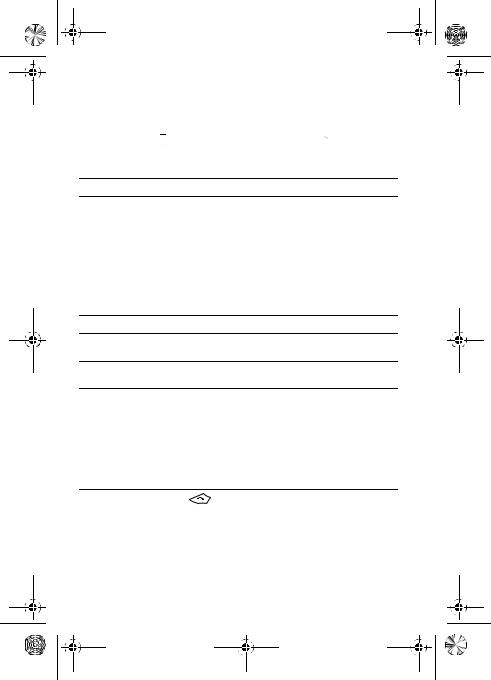
t729.book Page 19 Thursday, July 5, 2007 3:47 PM
Adjusting the Call Volume
During a call, use the Volume keys on the left side of the phone, to adjust the speaker volume.
Press the  key to increase the volume level and the
key to increase the volume level and the  key to decrease the level.
key to decrease the level.
In Idle mode, you can also adjust the ring volume using these keys.
Important!: For safety information related to Call Volume, see "Responsible Listening" on page 141.
Answering a Call
When somebody calls you, the phone rings and displays the incoming call image.
The caller’s phone number, or name if stored in Phonebook, displays.
1. Press the  key or the Accept soft key to answer the incoming call. If the Anykey answer option in the Extra Settings menu is activated, you can press any key to answer a call except for the
key or the Accept soft key to answer the incoming call. If the Anykey answer option in the Extra Settings menu is activated, you can press any key to answer a call except for the  key and the Reject soft key.
key and the Reject soft key.
Note: To reject an incoming call, press the Reject soft key or  key.
key.
2. Press the  key to end the call.
key to end the call.
Note: You can answer a call while using the Phonebook or menu features. After ending the call, the phone returns to the function screen you were previously using.
Call Records
All incoming, outgoing and missed calls are listed in the Call Records. You can also view Call time records.
1.In Idle mode, press the Menu soft key to access the Menu mode.
2.Using the Navigation keys, scroll to the Call records icon and press the Select soft key or the  key to enter the menu.
key to enter the menu.
Note: While in Idle mode, press the |
key to access the incoming, outgoing, and missing |
call records. |
|
|
|
19

t729.book Page 20 Thursday, July 5, 2007 3:47 PM
Call Records
The following Call Record options are available:
All calls
This menu lets you view the 90 most recent calls you received, dialed, and missed.
The name or number, if already stored in your Phonebook, displays with the number of occurrences for each number.
Note: At any time while you are in Call Records, you may use the Left or Right Navigation keys to scroll between All calls, Missed calls, Incoming calls, and Outgoing calls.
Missed calls
This menu lets you view the 30 most recent calls you received, but did not answer. The name and number, if already stored in your Phonebook, displays with the number of occurrences for each number.
Viewing Missed Calls
When you are unable to answer a call for any reason, you can find out who is calling you, if this service is available, so that you can call the person back.
The number of calls you missed displays on the idle screen immediately after a call is missed.
To view a missed call immediately:
1.If the display is off, press the volume key to turn the display on.
2.Press the View soft key.
The number corresponding to the most recently missed call displays, if available.
3.To scroll through the missed calls, press the Up or Down Navigation key.
4.To call the number displayed, press the  key.
key.
5.Press the Options soft key for the following options:
•Details: Displays details of the missed call including name, number, dates and times of the calls.
•Call back: Places a call back to the number.
•Send message: Allows you to send a Text message, Picture message, or Voice note back to the missed number.
•Save to Phonebook: Stores the number in your Phone memory.
•Delete: Allows you to delete the selected number or delete all call records.
•Add to block list: Adds the selected number to the blocked calls list.
Note: You can press the  key at any time to exit the Missed Call feature.
key at any time to exit the Missed Call feature.
Call Functions 20
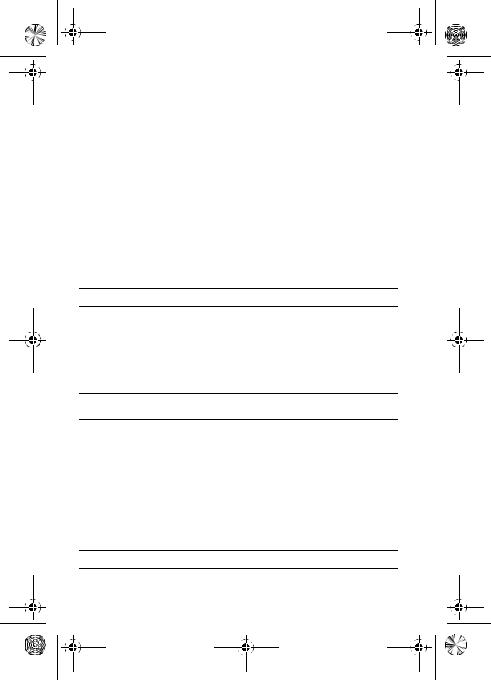
t729.book Page 21 Thursday, July 5, 2007 3:47 PM
Incoming calls
This menu lets you view the 30 most recent calls you received.
The name and number, if already stored in your Phonebook, is then displayed with the number of occurrences for each number.
Outgoing calls
This menu lets you view the 30 most recent calls you dialed.
The name and number, if already stored in your Phonebook, is then displayed with the number of occurrences for each number.
Delete all
This menu allows you to delete all of the records in each call record separately, or you can delete all of your call records at one time.
1.Highlight the type of calls you want to delete and press the  key to make a check mark.
key to make a check mark.
Note: Selecting the All calls check box automatically selects all the entries in the Delete all menu.
2.Press the Delete soft key to delete the calls.
3.When a confirmation message displays, press the Yes soft key or  key to confirm.
key to confirm.
Call time
This menu lets you view the time log for calls both made and received.
Note: The actual time invoiced by T-Mobile may differ from times displayed due to network features and service plan.
The following time logs are available:
•Last call time: shows the length of your last call.
•Total outgoing: shows the total length of all calls made since the timer was last reset.
•Total incoming: shows the total length of all calls received since the timer was last reset.
•Life time is: shows the total length of time for both incoming and outgoing calls. The length of call time must be at least 1 minute to increment this field. You cannot clear this information.
Note: To change this password, see "Change password" on page 116.
21

t729.book Page 22 Thursday, July 5, 2007 3:47 PM
Silent Mode
Silent Mode
Silent Mode is convenient when you wish to stop the phone from making any noise, (in a theater for example).
In Idle mode, press and hold the  key until the “Silent Mode Activated” message and the Silent Mode icon (
key until the “Silent Mode Activated” message and the Silent Mode icon (  ) display. In Silent Mode, instead of sounds, your phone vibrates.
) display. In Silent Mode, instead of sounds, your phone vibrates.
To exit and reactivate the previous sound settings, press and hold the  key again until the “Silent Mode Deactivated” message displays.The Silent Mode icon (
key again until the “Silent Mode Deactivated” message displays.The Silent Mode icon (  ) no longer displays.
) no longer displays.
Selecting Functions and Options
Your phone offers a set of customizable functions. These functions are arranged in menus and sub-menus, and accessed using the two soft keys. Each menu and sub-menu allows you to view and alter the settings of a particular function.
Soft Keys
The roles of the soft keys vary depending on the function you are currently using. The labels on the bottom line of the display just above each key indicate their current role.
Press the Left soft key for Menu mode.
Menu
Ph.Book
Press the Right soft key to access the
Ph.Book
menu.
Call Functions 22

t729.book Page 23 Thursday, July 5, 2007 3:47 PM
Selecting Options
To view the various functions and options available, you must select the one you want by:
1.Press the appropriate soft key.
2.To select the function displayed or the option highlighted, press the Select soft key or the  key.
key.
3.To view the next function or highlight the next option on a list, press the Down Navigation key.
4.To move back to the previous function or option on a list, press the Up key.
5.To move back up one level in the menu structure, press the Back soft key.
6.To exit the menu structure without changing the settings, press the
 key.
key.
In some functions, you are asked for a password or PIN. Enter the correct code and press the OK soft key or the  key.
key.
When you access a list of options, your phone highlights the currently active option. If, however, there are only two options, such as On/Off or Enable/Disable, your phone highlights the option that is not currently active, so that you can select it.
Options During a Call
Your phone provides a number of control functions that are available for use during a call.
Switching off the Microphone (Mute)
You can temporarily switch your phone’s microphone off, so that the other person cannot hear you.
Example: You wish to say something to a person in the room but do not want the person on the phone to hear you.
To switch the microphone off temporarily:
Press the Options soft key. Select the Mute option and press the
Select soft key or the  key. The other person can no longer hear you. The Mute icon (
key. The other person can no longer hear you. The Mute icon (  ) displays at the bottom left of the screen.
) displays at the bottom left of the screen.
To switch the microphone back on:
Press the Options soft key. Select the Unmute option and press the Select soft key or the  key. The other person can hear you again.
key. The other person can hear you again.
23

t729.book Page 24 Thursday, July 5, 2007 3:47 PM
Selecting Functions and Options
Putting a Call on Hold
You can place the current call on hold whenever you want. If your netowrk supports this service, you can also make another call while a call is in progress.
To place a call on hold:
1.Press the Options soft key, highlight the Hold option, then press the Select soft key or the  key.
key.
2.Press the Resume soft key to reactivate the call.
To make a new call while a call is in progress:
1.Enter the new phone number that you wish to dial or look it up in the Contact list.
2.Press the  key to dial the second call. The first call is then automatically put on hold. - Or -
key to dial the second call. The first call is then automatically put on hold. - Or -
1.Press the Options soft key, select Hold, and press the  key. This places the currently active call on hold and allows to make a new call.
key. This places the currently active call on hold and allows to make a new call.
2.Make the second call in the normal way.
When there is an active call and a call on hold, you may switch between the two calls by placing the current held call to active and then placing the other call on hold.
To switch between the two calls:
1.Press the Options soft key, select Swap, and press the  key. The current active call is placed on hold and the call on hold is then reactivated
key. The current active call is placed on hold and the call on hold is then reactivated
so that you can continue conversing with that person.
2.Press the  key when you are finished or want to end the call.
key when you are finished or want to end the call.
Using the Speakerphone
While on a call, you can use your Speakerphone by following these steps:
1.Press the Spkr on soft key.
2.To turn the Speakerphone off, press the Spkr off soft key.
Important!: For safety information related to speakerphone use, see "Responsible Listening" on page 141.
Call Functions 24

t729.book Page 25 Thursday, July 5, 2007 3:47 PM
Muting or Sending Key Tones
These options allow you to turn the key tones off or on. If the Keypad tone option is Off, your phone does not transmit the DTMF (Dual Tone Multi-Frequency) tones of the keys, which then allows you to press keys without hearing annoying key tones during a call.
Note: To communicate with answering machines or computerized telephone systems, the Send DTMF option must be selected.
Searching for a Number in Phonebook
You can search for a number in Phonebook during a call.
1.Press the Options soft key.
2.Press the Down Navigation key to highlight Phonebook and press the
 key.
key.
3.Press the Down Navigation key to highlight the Contact list option and press the Select soft key or the  key.
key.
With the Phonebook entries then listed:
4.Enter the name that you wish to find in the textbox located above the entries. If you enter the first few letters of the name, the Phonebook entries are listed starting with the first entry matching your input.
Or, use the Up or Down Navigation key to highlight the contact that you desire.
5.To view the highlighted entry, press the Options soft key.
6.Highlight the View option and press the Select soft key or the  key. The Contact information displays.
key. The Contact information displays.
For further details about the Phonebook feature, see "Finding a Phonebook Entry" on page 60.
25

t729.book Page 26 Thursday, July 5, 2007 3:47 PM
Selecting Functions and Options
Call Waiting
The Call waiting option must be set to Activate before you can answer an incoming call while another call is in progress. For more information, refer to "Call waiting" on page 114.
You are then notified of an incoming call with a call waiting tone.
To answer a new call while another call is in progress:
1.Press either the Accept soft key or the  key to answer the incoming call. The first call is automatically put on hold.
key to answer the incoming call. The first call is automatically put on hold.
2.To switch between the two calls, press the Options soft key, highlight Swap and press the Select soft key or the  key.
key.
3.To end a call on hold, press the Options soft key and select the End held call option. Then press the Select soft key or the  key.
key.
4.To end the current/remaining call, press the  key.
key.
Making a Multi-Party Call
A multi-party call is a network service that allows up to six people to take part simultaneously in a multi-party or conference call.
For further details about subscribing to this service, contact T-Mobile customer service.
Setting up a Multi-Party Call
1.Call the first participant in the normal way.
2.Press the Options soft key and select the New call option.
3.Call the second participant in the normal way. The first call is automatically placed on hold.
4.To join the first participant to this multi-party call, press the Options soft key and select Join. Press the Select soft key or the  key.
key.
Note: These first two calls are then grouped together on screen and displayed with an adjacent number corresponding to the order in which the calls were made.
5.Press the Options soft key and then select the New call option to add a new person to a second multi-party call group.
Call Functions 26

t729.book Page 27 Thursday, July 5, 2007 3:47 PM
6.Press the Options soft key or the  key. Select the Join option and press the Select soft key or the
key. Select the Join option and press the Select soft key or the  key.
key.
Note: There are a maximum of two callers that can be joined to a single multi-party line. Additional callers would participate in a new Multiparty session which can be held in conjunction with the previous multiparty call. Each of these multi-party calls can then be placed on hold or swapped.
Having a Private Conversation With One Participant
When there are two participants in a multi-party session, it might be necessary to place one of those participants on hold so that a private conversation can be held with a single caller. While you are in a multi-party call:
1.Press the Options soft key and choose the Split option. Press the Select soft key or the  key.
key.
The short list of call participants then displays with the first caller selected.
2.Press the Up or Down Navigation key to highlight the person with which you want to talk privately, and press the Select soft key or the  key.
key.
Note: You can now talk privately to that person while the other participants can continue to converse with each other. If there is only one other participant, that person is then placed on hold.
3.To return to the multi-party call, press the Options soft key and select
Join. Press the Select soft key or the  key. All of the multi-party call participants can now hear each other again.
key. All of the multi-party call participants can now hear each other again.
Dropping One Participant
1.Press the Options soft key and choose the Split option. Press the Select soft key or the  key. The short list of call participants displays.
key. The short list of call participants displays.
2.Highlight the person you want to keep and press the Select soft key or the
 key.
key.
3.Press the Options soft key and highlight Remove. Press the Select soft key or the  key. The remaining participant on hold is highlighted.
key. The remaining participant on hold is highlighted.
4.Press the Select soft key or the  key to drop the selected participant. This option allows you to continue talking to the other participants.
key to drop the selected participant. This option allows you to continue talking to the other participants.
5.When you want to end the multi-party call, press the  key.
key.
27
